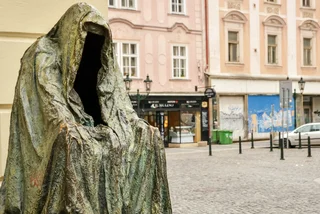The sun is shining (at times.) The birds are singing (most mornings.) It must be spring! Shake off the winter doldrums and burst forth into a new season. Prague and the rest of the country are getting into the mood too.
The Easter holiday is full of fun traditions in the Czech Republic. Under Communism, Easter as a religious holiday was discouraged, so it was more of a welcome to spring time. One of the most interesting, and perhaps controversial, traditions is the story of the pomlázka. This is a stick made from willow branches and often decorated with strips of colored paper or ribbons. You´ve probably noticed them around town already. The pomlázka is thought to be a tool for youth, beauty, health and/or fertility – depending on your source. It was originally a pagan ritual used to chase away illness and bad spirits and bring health and youth to whoever was whipped, including barnyard animals.
The custom is for woman and girls to spend Easter Sunday decorating eggs and making sweets. The men and boys spend the day constructing their pomlázkas. Come Easter Monday (a public holiday here, April 13 this year) the males run around town whipping the girls and reciting a “charming” poem. The fair ladies, having been duly beaten, thank the men with gifts of colored eggs, sweets, and if they are older, shots of slivovice. You don´t see this happening too often in Prague – so no whipping worries wandering around town Easter Monday. Most of these customs are practiced in smaller towns and villages.
If you´d like to truly join in the fun, here´s the Easter whipping poem:
Hody hody doprovody
dejte vejce malovany
Nedate-li malovany
dejte aspon bily
však Vam slepička snese jiny
Loosely translated (although the first line is really old Czech that´s hard to translate) it goes something like this:
“Give me a colored egg, if you won´t give me a colored egg, give me a white one and get your hen to lay another.”
Decorating Easter eggs, or kraslice, is another tradition – though not practiced as artistically as in the past. You will find many beautifully decorated eggs all over the city. Often these are hand painted, using such materials as beeswax, straw, watercolors or onion peels. From now until April 19, Easter markets will be set up at Old Town Square, Wenceslas Square and smaller venues around town, like near Anděl. On Old Town Square you can enjoy the huge decorated birch tree, and there will be children´s workshops happening as well. These are a good place to pick up Easter eggs, pomlázkas as well as some traditional Easter foods.
As with all holidays, the meal is often the most important part. Those not fond of the Christmas carp custom, may prefer an Easter lamb dinner. A roast lamb is often accompanied by a stuffing with nettles and parsley. Also popular are lamb shaped cakes, usually covered in a chocolate icing. I´ve already seen these available to purchase in Billa, so don´t stress about how to bake a cake in the shape of a lamb. Mazanec is a lemon-flavored cake with almonds and raisins. A cross is usually cut into the dough before being baked.
A new Easter event in Prague this year is the Easter Music Festival (www.fok.cz.) A series of concerts featuring compositions from the Middle Ages through the present will take place April 5-14 at the Rudolfinum and Municipal House.
No fooling, April 1 marks the start of tourist season. That means all the castles and chateaux that have lain cold and dormant since the fall will throw open their doors to guests. If you´d like to combine an out of town visit with an Easter fair; visit Křivoklát Castle (www.krivoklat.cz) April 11-13 or Sychrov Chateau (www.zamek-sychrov.cz) April 4 & 5.
More fun times are around the corner after Easter. Another unique ritual is the annual witch burning. History has it that evil spirits are extra powerful during the night of April 30 to May 1. Traditionally, fires were lit on hillsides to protect homes and villages from witches. Recent custom has people actually burning homemade witches in a symbolic “burning away” of winter and welcoming spring. A fire is lit to flush out the winter spirits and an effigy of a witch is burnt. Some stories include women cleaning their homes on April 30 and then burning their brooms that night in order to ensure a clean house free of witches. Today, if you visit a smaller town or village, you´ll probably still see a witch burning event.
On May 1 (another public holiday) there are a couple rituals to participate in. First there´s the annual May pole celebration, which can still be seen in some towns, particularly in Moravia. The top of a tree is cut off and decorated with flowers and ribbons. Lovers both young and old alike should make a pilgrimage up Petřín Hill to the statue of poet Karel Hznek Mácha. Bring some flowers and steal a kiss (from your loved one, not the statue.) Mácha wrote the 19th century epic poem ; which is actually a gloomy tale of unrequited love, but don´t let that spoil your fun. And everyone should kiss under a flowering cherry tree on May 1. You´ll have good health and your love will stand the test of time. Or so the story goes












 Reading time: 4 minutes
Reading time: 4 minutes 






















